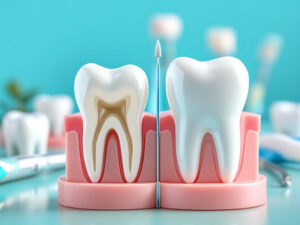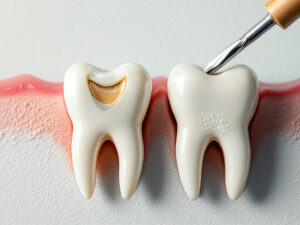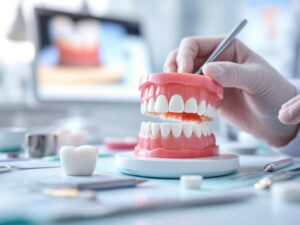Understanding Root Canal Treatment
Purpose of Root Canals
Root canals are common procedures designed to remove infected pulp from inside a tooth. This treatment is often necessary when bacteria reach the pulp, causing pain or inflammation. The primary purposes of root canal treatment include:
- Relieving Pain: It alleviates discomfort caused by infection or inflammation within the tooth.
- Saving Your Tooth: By removing the infected pulp, the tooth can be preserved, preventing the need for extraction.
- Preventing Infection Spread: Treating the pulp infection can stop the bacteria from spreading to surrounding tissues, which could lead to more serious dental issues.
If you’re experiencing symptoms such as persistent tooth pain or sensitivity, consider reading more about signs you need a root canal.
Process and Duration
The root canal procedure typically involves several key steps, which may vary depending on your specific situation. The average duration of a root canal can range based on these factors:
| Procedure Step | Description |
|---|---|
| Diagnosis | Your dentist will take X-rays and assess symptoms. |
| Local Anesthesia | Anesthesia is applied to minimize discomfort during the procedure. |
| Tooth Isolation | The tooth is isolated using a rubber dam. |
| Pulp Removal | Infected pulp is removed, and the canals are cleaned out. |
| Filling the Canals | The canals are filled with a biocompatible material. |
| Temporary Filling | A temporary filling is placed until a permanent crown can be made. |
The entire process can take about 1 to 2 hours, depending on the complexity of the case. For more detailed information about the process, you can check our article on root canal procedure steps and find out how long does a root canal take.
After the procedure, recovery usually takes less than a week. Most individuals experience lingering sensitivity rather than long-lasting pain. If pain persists, it’s important to contact your dental provider.
Good oral hygiene practices are essential for avoiding further complications or the need for additional procedures (Cleveland Clinic). For more detailed post-treatment care, see our article on root canal home care aftercare.
Signs You May Need a Root Canal
If you are experiencing persistent tooth discomfort, understanding the signs that may indicate the need for a root canal is crucial. These signs can manifest as tooth pain indicators or visible signs of infection.
Tooth Pain Indicators
Severe or lasting tooth pain is one of the most common signals that you may need a root canal. This pain often varies in intensity and can be triggered by pressure, chewing, or even when at rest. Additional symptoms include:
| Symptom | Description |
|---|---|
| Sensitivity to Hot and Cold | Lingering sensitivity after consuming hot or cold beverages can indicate nerve damage. |
| Swelling | Facial or jaw swelling around the affected tooth may suggest an infection. |
| Recurring Gum Pimple | A pimple-like bump on the gum can indicate a dental abscess, which is often associated with infection Springville Dentist. |
If you notice these symptoms, it is important to seek advice from a dental professional. They can provide you with more information on what is root canal treatment and whether it’s necessary for your situation.
Visible Signs of Infection
In addition to tooth pain, there are visible signs that may indicate an infection requiring a root canal. These include:
| Sign | Description |
|---|---|
| Discolored Teeth | Teeth that appear grey or black may be indicative of severe decay or tissue breakdown Springville Dentist. |
| Dental Abscess | A pimple-like bump on the gum line suggests a gum infection that may necessitate treatment with antibiotics and a root canal (Springville Dentist). |
If you are seeing any of these symptoms, it is important to consider getting a dental evaluation as soon as possible. Early intervention can make a significant difference in your treatment options. Understanding these signs is part of proactive dental care, which helps in preserving your natural teeth. For more information, you can check out our article on root canal vs tooth extraction to see the benefits of keeping your natural teeth.
Root Canal Recovery and Aftercare
Recovery Timeline
Understanding the recovery process after a root canal can help you manage your expectations. Most root canals take about 60 to 90 minutes to complete, and some may require more than one visit. Typically, recovery takes less than a week, with most individuals experiencing some lingering sensitivity but no long-lasting pain.
| Recovery Stage | Duration | Description |
|---|---|---|
| Initial Recovery | 1-3 days | Most people will feel sensitivity or tenderness. Pain often subsides within a few days. |
| Full Recovery | Less than a week | Minor sensitivity may linger, but significant discomfort should be resolved. If issues persist, contact your provider. |
Managing Post-Treatment Discomfort
After undergoing a root canal, managing any post-treatment discomfort is crucial. It is common to experience inflammation and irritation in the tissues surrounding the tooth, which can lead to temporary discomfort (Campbell Station Dentistry). Here are some effective pain relief tips:
-
Pain Relief Medications: Over-the-counter medications such as ibuprofen or acetaminophen can help alleviate discomfort. Always follow the recommended dosage on the label.
-
Warm Saltwater Rinses: Rinsing with warm saltwater can help reduce inflammation and promote healing. Mix about half a teaspoon of salt in eight ounces of warm water and rinse several times a day.
-
Healthy Diet: Consume a diet rich in nutrients that promote healing. Focus on soft foods initially, gradually reintroducing harder foods as you feel comfortable.
-
Stay Hydrated: Proper hydration is essential for healing. Aim to drink plenty of water throughout the day.
-
Avoid Smoking: If you smoke, try to avoid tobacco products after your root canal to encourage healing.
If discomfort intensifies or does not improve after a few days, reach out to your dentist or endodontist for an evaluation. For more comprehensive aftercare recommendations, refer to our guide on root canal home care aftercare.
Following these steps can help ensure a smooth and successful recovery after your procedure.
Root Canal Pain Relief Techniques
After undergoing a root canal, you may experience some discomfort. Fortunately, there are effective techniques to alleviate this pain and help you feel more comfortable during the recovery process.
Over-the-Counter Medications
Over-the-counter pain relievers can be an effective way to manage post-treatment pain. Common medications include acetaminophen (Tylenol) and ibuprofen (Advil, Motrin IB). These options can help relieve mild pain and sensitivity that may occur after the procedure. It is essential to consult with your doctor before taking any medication to prevent potential interactions with other prescriptions or supplements (Healthline).
| Medication | Uses |
|---|---|
| Acetaminophen | Reduces pain |
| Ibuprofen | Alleviates pain and inflammation |
| Aspirin | Eases discomfort and inflammation |
| Aleve | Effective for pain relief |
If pain persists after taking ibuprofen, you may consider adding acetaminophen every six hours or consulting your dentist about prescription options like Tylenol with codeine or Vicodin for more severe discomfort. It is vital to note that if you are prescribed narcotics, you should not drive or operate heavy machinery until you know how they affect you.
Home Remedies for Pain Relief
While medications can provide significant relief, you can also implement home remedies to help manage discomfort after your root canal procedure. Some effective methods include:
- Cold Compress: Applying a cold pack to the outside of your cheek near the affected area can help reduce swelling and numb the pain.
- Warm Saltwater Rinse: Gargling with warm salt water can help keep your mouth clean and soothe any inflammation.
- Avoid Hard Foods: Stick to soft foods in the days immediately following your treatment to prevent irritation of the affected tooth.
- Elevation: Keeping your head elevated while resting can help reduce blood flow to the affected area, minimizing inflammation and discomfort.
Practicing good oral hygiene is also crucial. Regular brushing and flossing should continue to prevent any further complications. For more information on aftercare following a root canal, refer to our article on root canal home care aftercare.
By utilizing both over-the-counter medications and home remedies, you can effectively manage pain and promote a smoother recovery process following your root canal treatment. Remember to consult your dental professional if you have any lingering concerns about your recovery.
Addressing Post-Root Canal Complications
Root canal procedures are often successful, but complications can arise. It is crucial to be aware of these issues and how to handle them, ensuring your comfort and the longevity of your dental health.
Failed Root Canals
A failed root canal can occur if the infection persists or resurfaces. This may happen for several reasons, including:
- Incomplete cleaning of the root canal system
- Complex root canal anatomy that is difficult to access
- New infections from cavities or gum disease
Approximately 3% to 6% of individuals may experience severe pain after a root canal procedure, indicating a potential complication. If you notice persistent pain or swelling, it is essential to contact your dentist or endodontist for a reassessment.
If a root canal fails, your dentist may recommend further treatment options, such as:
| Treatment Option | Description |
|---|---|
| Retreatment | Re-cleaning the canal and sealing it again. |
| Apicoectomy | Surgical procedure to remove the tip of the root and seal the canal. |
| Extraction | Removal of the tooth if other treatments are unsuccessful. |
Explore more about root canal complications and their implications.
Strategies for Persisting Pain
Experiencing ongoing pain after a root canal can be concerning. Here are some strategies to manage this discomfort:
- Medication: Over-the-counter options like Ibuprofen or Regular Strength Tylenol can help alleviate mild to moderate pain. If pain is severe, your dentist may prescribe narcotics. Remember to not exceed 3000 mg of acetaminophen in a 24-hour period (Elite Endodontics Ohio).
- Cold Compress: Applying a cold pack externally on the affected area can reduce swelling and numb the discomfort.
- Rest: Allow your body time to heal. Take a break from strenuous activities and avoid hard or chewy foods to minimize stress on the tooth.
- Follow-Up: Schedule a follow-up appointment with your dentist if pain persists beyond four to five days (Medical News Today). Early intervention can prevent further complications.
It is essential to maintain good oral hygiene and adhere to your dentist’s root canal home care aftercare instructions for effective healing. By being proactive and attentive to your symptoms, you can navigate the recovery process effectively and enhance your dental health.
Preventive Measures and Oral Care Tips
Ensuring your dental health can significantly minimize the risk of requiring a root canal. By following effective oral care practices and preventive measures, you can maintain your natural teeth and avoid complications.
Dental Hygiene Practices
Implementing good dental hygiene is crucial for preventing infection and tooth decay, both of which can lead to the need for a root canal. Here are some fundamental practices to follow:
| Practice | Recommendation |
|---|---|
| Brushing | Brush your teeth at least twice a day with fluoride toothpaste. |
| Flossing | Floss daily to remove plaque between teeth. |
| Dental Checkups | Schedule regular dental visits every six months for professional cleaning and check-ups. |
| Mouthwash | Use an antibacterial mouthwash to reduce plaque and promote oral hygiene. |
| Diet | Limit sugary snacks and beverages that can lead to tooth decay. |
By maintaining these habits, you can help keep your teeth and gums healthy, reducing the likelihood of needing treatments like root canals. Good oral hygiene practices can significantly decrease the risk of complications and discomfort associated with dental procedures, (Palmetto Family Dental).
Avoiding Future Root Canal Needs
In addition to proper dental care, certain lifestyle choices can help keep your teeth healthy and strong:
- Avoid Hard Foods: Minimize chewing on hard foods that can crack or damage teeth, elevating the risk of infection.
- Wear a Mouthguard: If you play contact sports or grind your teeth, consider wearing a mouthguard to protect your teeth from injury.
- Stay Hydrated: Drink plenty of water to help wash away food particles and prevent dry mouth, which can contribute to tooth decay.
- Quit Smoking: Smoking can impact oral health and increase the risk of gum disease, making root canal treatment more likely.
Taking proactive steps can help preserve your natural teeth and require fewer dental interventions in the future. As you focus on your dental care, remember to stay attentive to any changes in your oral health and consult your dentist regularly. For more information on dental health, explore our articles such as what is a root canal and signs you need a root canal.










